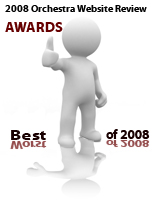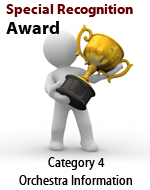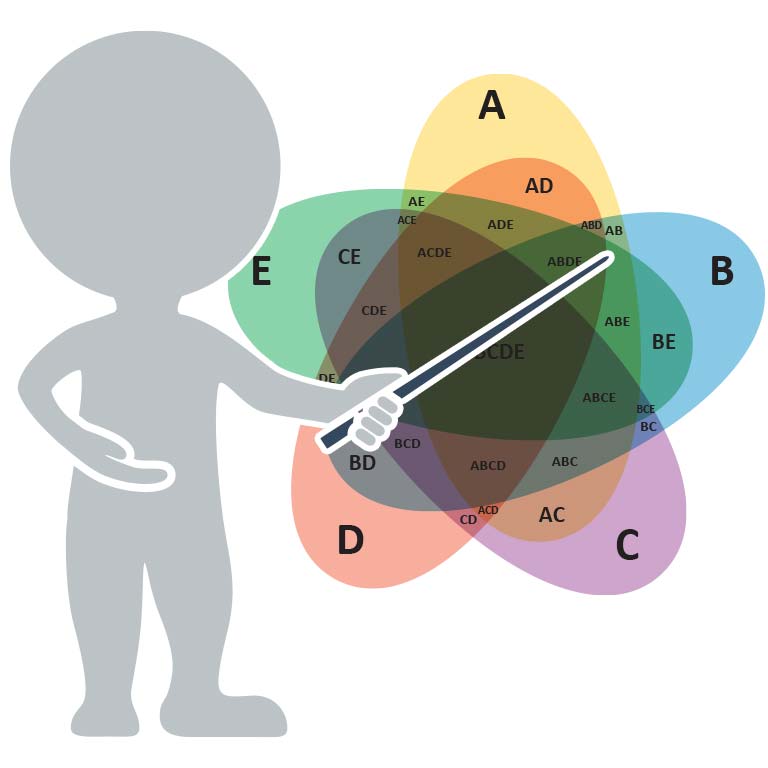During every orchestra website review, several orchestras deserve special recognition for how well they satisfied evaluation requirements as well as demonstrating particular originality and creativity for specific website components. As such, the Special Recognition Awards are designed to highlight individual achievements and promote them as benchmarks within the business…
 Conversely, the Worst of 2008 examines organizations that could stand to improve particularly damaging components and/or practices. Although an individual orchestra may have had an overall low score in this year’s review that certainly doesn’t imply that they didn’t do a particularly good job at satisfying the requirements of any individual category or respective sub-categories. Consequently, the Special Recognition Awards are designed to highlight individual accomplishment wherever it is found.
Conversely, the Worst of 2008 examines organizations that could stand to improve particularly damaging components and/or practices. Although an individual orchestra may have had an overall low score in this year’s review that certainly doesn’t imply that they didn’t do a particularly good job at satisfying the requirements of any individual category or respective sub-categories. Consequently, the Special Recognition Awards are designed to highlight individual accomplishment wherever it is found.
Category 1: Performance Schedule
 When it comes down to it, the KISS method (Keep It Simple, Stupid) is almost always the way to go when trying to quickly convey basic performance information. To this end, orchestras which don’t confuse complex with complicated deserve notice. Nothing quite beats a nice, obvious “next concert” notice like the one employed at the Chicago Symphony homepage. Likewise, the LA Chamber Orchestra (an orchestra website jam packed with charm) makes it painfully easy to see what’s next on their concert schedule, although they do fail to provide an interactive concert calendar.
When it comes down to it, the KISS method (Keep It Simple, Stupid) is almost always the way to go when trying to quickly convey basic performance information. To this end, orchestras which don’t confuse complex with complicated deserve notice. Nothing quite beats a nice, obvious “next concert” notice like the one employed at the Chicago Symphony homepage. Likewise, the LA Chamber Orchestra (an orchestra website jam packed with charm) makes it painfully easy to see what’s next on their concert schedule, although they do fail to provide an interactive concert calendar.
Speaking of interactive concert calendars, the San Francisco Symphony website utilizes a KISS perfect calendar that provides basic concert info and a related PR photo for any concert event a user mouses over. Proving that smaller budget groups can keep up with their bigger budget peers, the Sarasota Orchestra and Tucson Symphony offer a simple pop-up style interactive calendar that provides users with basic concert info quickly and easily.
Category 2: Purchasing Tickets
 The Nashville Symphony’s interactive seat selection feature continues to be years ahead of comparable offerings from any other professional orchestra in the review; simply put, it exudes the essence of “online sheik.” If you haven’t done so yet, visit their virtual seating chart yourself to discover just how much fun it is to find your ideal seat.
The Nashville Symphony’s interactive seat selection feature continues to be years ahead of comparable offerings from any other professional orchestra in the review; simply put, it exudes the essence of “online sheik.” If you haven’t done so yet, visit their virtual seating chart yourself to discover just how much fun it is to find your ideal seat.
The Harrisburg Symphony continues to demonstrate smaller budget ensembles can create a ticket buying experience that provides users with views of the stage from seating sections as well as the ability to select individual seats. Speaking of smaller budget groups providing worthwhile ticket buying experiences, there were a few orchestras which allowed ticket buyers to donate tickets back via an online form. One of the better examples was the Huntsville Symphony, which went out of their way to make sure online ticket buyers not only knew about the option but made it very easy for them to take advantage of the service.
In the realm of online subscription purchases, the Chicago Symphony leaped to the front of the pack by offering a truly wonderful “build your own subscription” option. Operating entirely on a single, seamless webpage users just expand each month’s scheudle then select the concerts and individual seats they want. Any applicable discounts were applied automatically and the entire process worked flawlessly in FireFox and IE browsers. Brilliant. Although their offering didn’t function as smoothly as the CSO model, the Baltimore Symphony provided users with a very similar experience that was, overall, excellent.
Category 3: Making Donations
 Among the variety of sub-categories to improve in the 2008 reviews, the variety and number of orchestras providing online giving opportunities increased a great deal. Among the larger budget orchestras, the Chicago Symphony continues to maintain a straightforward yet diverse design they pioneered years ago. The recently redesigned Philadelphia Orchestra website offers a very clean and friendly online donation page providing users with several giving categories.
Among the variety of sub-categories to improve in the 2008 reviews, the variety and number of orchestras providing online giving opportunities increased a great deal. Among the larger budget orchestras, the Chicago Symphony continues to maintain a straightforward yet diverse design they pioneered years ago. The recently redesigned Philadelphia Orchestra website offers a very clean and friendly online donation page providing users with several giving categories.
In fact, several smaller budget orchestras provided users with multiple giving opportunities including the ability to make regularly reoccurring payments or payments in installments. The Long Beach Symphony, Charleston Symphony, and Louisville Symphony all provide users this level of online giving functionality.
Back for a second year is the LA Chamber Orchestra’s “Sound Investment” program which allows potential donors to contribute toward a special new music fund. Orchestras of all size budgets can learn from the LACO’s example and dedication toward funding new music programs.
Category 4: Orchestra Information
 Although a fraction of the orchestras in the 2008 review offer any sort email contact for musicians, one group stood out by offering not only bio and pics for nearly every musician but email contact info as well: The Naples Philharmonic. The New Mexico Symphony continued to provide an email address at the nmso.org extension posted for each musician in the orchestra and when clicking on a musician’s respective email link, it automatically inserts “Please forward to [Musician Name]” in the subject field. Speaking of email, the Philadelphia Orchestra was the only organization to post a complete array of contact information for the Board including mailing address, phone, and email.
Although a fraction of the orchestras in the 2008 review offer any sort email contact for musicians, one group stood out by offering not only bio and pics for nearly every musician but email contact info as well: The Naples Philharmonic. The New Mexico Symphony continued to provide an email address at the nmso.org extension posted for each musician in the orchestra and when clicking on a musician’s respective email link, it automatically inserts “Please forward to [Musician Name]” in the subject field. Speaking of email, the Philadelphia Orchestra was the only organization to post a complete array of contact information for the Board including mailing address, phone, and email.
Although the page navigation is really showing its age, the Oregon Symphony receives its fifth straight special recognition award for the best method to showcase musicians. The formula, Biography-Musician Moment-Player Portrait-Musical Legacy, remains unchanged since its inception several years ago and serves as the Jones other orchestras need to keep up with. Also worth noting is the Musicians’ Corner at the Baltimore Symphony. Not only do they provide Oregonesque profiles for some musicians but they have a wealth of off-the-beaten-path style content about the musicians and even provide listings of recitals and private chamber groups. It is worth mentioning that much of this content was incorporated from a separate website created and maintained directly by the BSO musicians.
When it came to institutional transparency, most orchestras continued to demonstrate that they just don’t want anyone asking questions. Notable exceptions to this rule were the Nashville Symphony, New York Philharmonic, Pittsburgh Symphony, and Toledo Symphony which were the only orchestras to provide copies of annual reports and direct access to IRS Form 990s.
Category 5: Dynamic Content
 Although a small percentage of orchestras in the 2008 review offered users any sort of RSS feeds for media or concert schedule data, the Chicago Symphony demonstrated how much they truly “get it” by not only offering several varieties of RSS feeds but many were listed right on the website’s home page (tomorrow’s article will examine that feature in greater detail). In addition to Chicago, the LA Philharmonic, Nashville Symphony, and the SLSO all offered varying degrees of RSS feeds from media pages and/or concert schedules.
Although a small percentage of orchestras in the 2008 review offered users any sort of RSS feeds for media or concert schedule data, the Chicago Symphony demonstrated how much they truly “get it” by not only offering several varieties of RSS feeds but many were listed right on the website’s home page (tomorrow’s article will examine that feature in greater detail). In addition to Chicago, the LA Philharmonic, Nashville Symphony, and the SLSO all offered varying degrees of RSS feeds from media pages and/or concert schedules.
A number of orchestras established blogs this year; unfortunately, a vast majority of them are used for PR regurgitation. Some notable exceptions include Minnesota Orchestra’s Inside The Classics blog and Eddie Silva’s SLSO blog. Both offerings are filled with frequently updated, sincere content. The former is brave enough to toe-the-line every now and then and post something on a relatively controversial topic outside the realm of its respective ensemble. If every orchestra could follow this example, the world of classical music would be an entirely different (and better) environment.
Moving on to traditional media content, the Chicago Symphony provided a very “new media friendly” version of a traditional press page. At their Publicity Photo page they have an excellent note to bloggers encouraging them to use the images but reminding them to provide the appropriate credit and link back to the CSO website. When it comes to neat and tidy press release pages, the Baltimore Symphony deserves recognition for offering a highly organized format that presents an excerpt, downloadable copy, and three relevant photos for each release.
Category 6: Functionality
 As orchestra websites evolve, so does the amount of content they include and putting users in contact with the information they want is an increasingly complex challenge. For the past three years, the Chicago Symphony and Nashville Symphony continue to put an effective and straightforward navigation structure to good use.
As orchestra websites evolve, so does the amount of content they include and putting users in contact with the information they want is an increasingly complex challenge. For the past three years, the Chicago Symphony and Nashville Symphony continue to put an effective and straightforward navigation structure to good use.
The Elusive Award
Ever since the inaugural orchestra website review in 2004, there has never been an orchestra that provided media contact information for a musicians’ representative. The business is filled with those who like to talk about eliminating the “us against them” syndrome but apparently no one out there is willing to take the first step in putting their money where their mouth is by listing a name and contact info for an elected musician representative. Is anyone willing to be the first for the 2009 review?
The Best of 2008: Biggest Gains
 You know what they say about success; it breeds expectation. Nevertheless, it is great to see such a wide variety of budget size organizations enjoy large increases in rank and/or score. The trick for next season is to maintain and improve on these results. The Top 5 orchestra websites to experience an increase in rank and score include:
You know what they say about success; it breeds expectation. Nevertheless, it is great to see such a wide variety of budget size organizations enjoy large increases in rank and/or score. The trick for next season is to maintain and improve on these results. The Top 5 orchestra websites to experience an increase in rank and score include:
Largest Gains In Rank
- Toledo Symphony increased 56 positions
- Charlotte Symphony increased 44 positions
- Los Angeles Philharmonic increased 43 positions
- Elgin Symphony increased 36 positions
- Dallas Symphony increased 34 positions
Largest Gains In Points
- Toledo Symphony increased 32.51 points
- Elgin Symphony increased 28.07 points
- Los Angeles Philharmonic increased 25.20 points
- Charlotte Symphony increased 20.86 points
- Knoxville Symphony increased 20.07 points
The Worst of 2008: Worst Online Ticket Sales And Donations
 The only thing worse than forcing ticket buyers through a frustrating online ticket buying experience is not offering online ticket sales at all. Fortunately, the number of orchestras on this list decreased by exactly half as compared to the 2007 review. Nevertheless, the following orchestras did not offer online single ticket sales at the time of the review (listed alphabetically):
The only thing worse than forcing ticket buyers through a frustrating online ticket buying experience is not offering online ticket sales at all. Fortunately, the number of orchestras on this list decreased by exactly half as compared to the 2007 review. Nevertheless, the following orchestras did not offer online single ticket sales at the time of the review (listed alphabetically):
- California Symphony
- Delaware Symphony
- Knoxville Symphony
- Long Island Philharmonic
- Memphis Symphony
- Mississippi Symphony
There is simply no good reason why an orchestra shouldn’t expend the effort to provide an opportunity for patrons to make online donations. Over the past two years, the number of low to no cost online donation tools allow even the smallest budget organizations to increase their contributed revenue through e-commerce solutions. Fortunately, a sizeable number of orchestras took advantage of these tools and as a result, the number of orchestras on this list decreased by a third. Nevertheless, the following orchestras did not accept online donations at the time of the review (listed alphabetically):
- Colorado Symphony
- Dayton Philharmonic
- Delaware Symphony
- Fort Wayne Philharmonic
- Jacksonville Symphony
- Long Island Philharmonic
- Memphis Symphony
- Mississippi Symphony
- Santa Rosa Symphony
- Sarasota Symphony
- Utah Symphony
- Wichita Symphony
- Wisconsin Chamber Orchestra
The Worst of 2008: Narcissistic Executive Directors
 In November of 2003, I published an article entitled I Go To The Symphony For Their Executive Director? which chronicles the bizarre habit of some orchestra executives who feel compelled to post their pictures, biographies, or personal messages to patrons on the organization’s website when there is nothing beyond scant information about the musicians. Granted, there is absolutely nothing improper with posting biographical data, photographs, and personal messages from or about executives, but when those endeavors eclipse learning about the actual musicians it is time for the organization to reevaluate its priorities.
In November of 2003, I published an article entitled I Go To The Symphony For Their Executive Director? which chronicles the bizarre habit of some orchestra executives who feel compelled to post their pictures, biographies, or personal messages to patrons on the organization’s website when there is nothing beyond scant information about the musicians. Granted, there is absolutely nothing improper with posting biographical data, photographs, and personal messages from or about executives, but when those endeavors eclipse learning about the actual musicians it is time for the organization to reevaluate its priorities.
On a positive note, the number of executives on this list decreased by nearly 60 percent and only one name on the list is a repeat offender.
California Symphony
For the fourth consecutive year, California Symphony Executive Director, Stacey Street, maintains a full color picture and biography although there is nothing more than a text-only orchestra roster. Apparently, there is no issue with updating the website as Ms. Street’s bio has been updated from last year’s review. If this were an episode of The Simpsons, perhaps an appropriate catch phrase at this point might be “Most narcissistic orchestra executive. Ever.”
Long Beach Symphony Orchestra
Making her first appearance on the list this year is LBSO Executive Director, Nancy James Fox who (at least compared to her California Symphony counterpart) maintains a relatively brief bio; unfortunately, there is only a text-only orchestra roster. At the same time, the LBSO website has provided some biographical information for some musicians in previous reviews and given the fact that the website underwent a major overhaul since last year, here’s hoping that they haven’t yet finished inputting data and musician bios and/or contact info are on the way.
St. Louis Symphony Orchestra (but only kind of)
Although the SLSO website doesn’t feature a bio about their President and Executive Director, Fred Bronstein, at the sake of musician info (in fact, the SLSO site has very nice musician photo/bio blurbs) it does list Mr. Bronstein on the musician’s roster page. There’s a time and place for everything and given the fact that the SLSO website maintains separate listings for board members, administrators, and artists there really isn’t any need to list executives on artist pages.
So there you have it, a lot of the best and a bit of the worst from the 2008 Orchestra Website Review. Overall, things are beginning to sincerely look up for orchestra websites. Hopefully, the 2009 reviews will be the first year where the average score exceeds 80/100!



Point well taken on musicians’ elected representative contact info.
On the Executive Director bios: I agree they should not be at the expense of musician information, and certainly no one ever bought a ticket to watch the Executive Director work. I do think a case can be made that there are some folks – donors, patrons, sponsors, business community, etc – who want to know “who’s in charge,” and an Exec Dir bio can help satisfy that curiosity and (hopefully) bolster confidence in the organization. So I don’t think it’s bad form in and of itself, as long as it doesn’t give the impression that the show is somehow about the management.
I entirely agree Paul, having executive (and all administrative and even board officer) bios up on the website is a good thing for all of the reasons you mentioned. It just comes down to drawing a clear line as to where that activity draws attention away from the musicians or if resources needed to post that info is diverted from posting more information about the musicians is where groups get into trouble. At the same time, I think the sharp drop in the number of groups on that list this year is quite telling (and in a very good way) and I wouldn’t be the least bit surprised if next year’s review didn’t even have a list!
Musical notes pictured backwards (upward stem but to the left)? Annoying but it seems to pass in things like giftwrap and some ads… however, it ridiculous on an orchestral website. Shame on the California Symphony.
Logos are a fascinating topic but as a quick point of clarification, logos were not included in the official review criteria. At the same time, I do think it would be interesting to compare all of the logos from orchestras included in the review and perhaps let readers vote on which ones they like the best.
Are you only looking at US orchestra websites? If so, might be best to clarify that in the title.
Thanks for your note. The website reviews are divided into two series; one for US orchestras and the other for Canadian orchestras. I apologize for any confusion but since the blog focuses mostly on the North American orchestra business that perspective is taken as a given in titling. Regardless, you have a good point and if there is some way to help marginalize the sort of confusion you experienced, I’ll be happy to implement it for future reviews.
It looks to me like the California Symphony website includes a picture and bio for each of its leaders: the board president, executive director, music director and concert master. On recognizing that, it doesn’t seem over the top to have the ED’s information there, just inclusive.
I don’t think there was a single instance of a website that didn’t include a photo/bio for the music director. Nevertheless, the heart of the matter continues to focus on whether or not promotional efforts of non-artistic personnel eclipses learning about the actual musicians.
If you can’t bother to convey a bit of information about the people responsible for actually creating the music, why bother to list them at all? Consequently, the group takes on an image of a concert presenter as opposed to a dedicated symphony orchestra.
Given the sharp decrease in orchestras where the executive administrators take precedence over musicians, it seems clear that the business has adopted this mindset and if the California Symphony (or any professional orchestra for that matter) plans to measure up to benchmarks incorporated by their peers, then they risk being marginalized.
I would like to say that i like the fact that you are making seating very affordable and so that everyone would be able to see the stage because i recently went to a symphony and you couldn’t really see the stage unless you were in the first 15 rows it was pretty upsetting.
Jackie